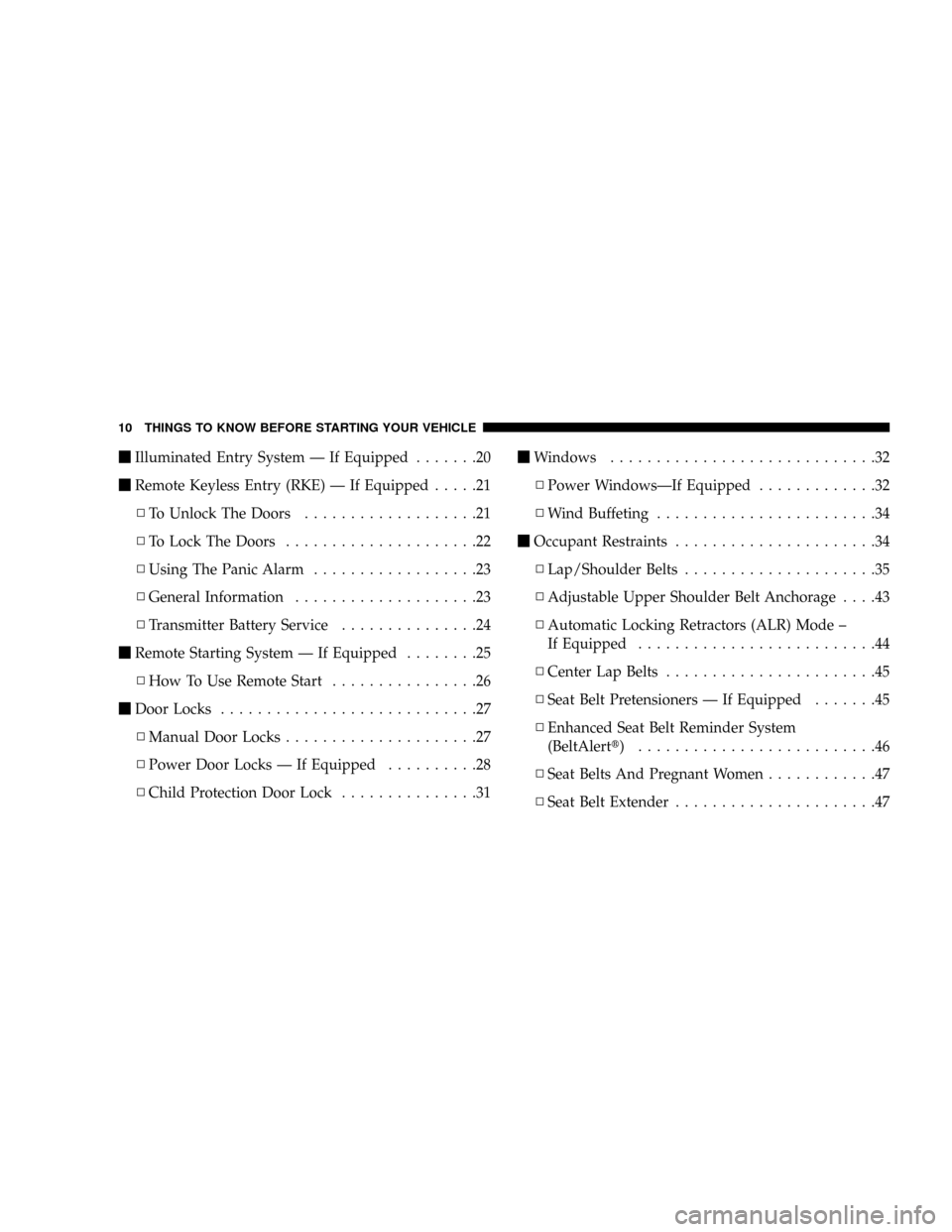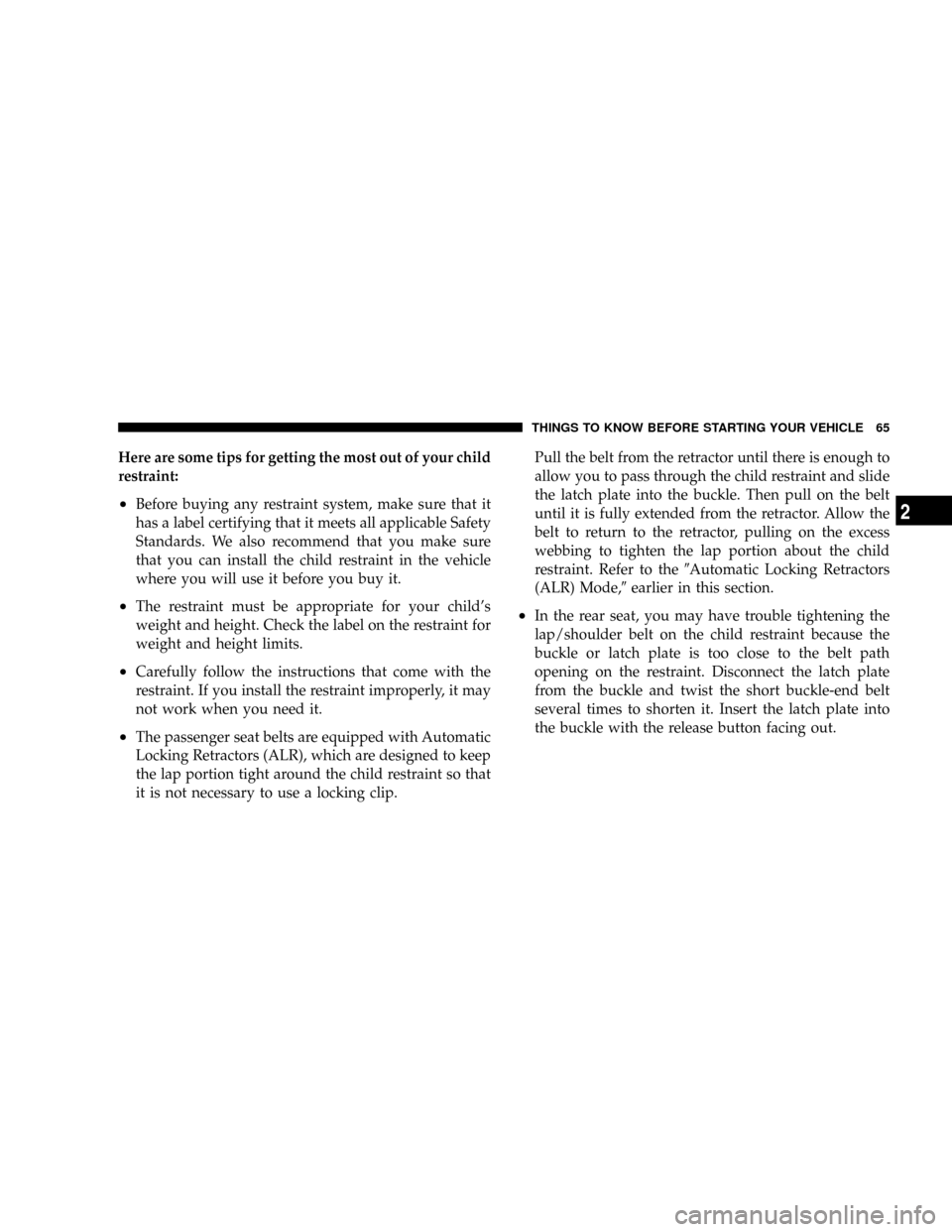Page 12 of 554

mIlluminated Entry System Ð If Equipped.......20
mRemote Keyless Entry (RKE) Ð If Equipped.....21
NTo Unlock The Doors...................21
NTo Lock The Doors.....................22
NUsing The Panic Alarm..................23
NGeneral Information....................23
NTransmitter Battery Service...............24
mRemote Starting System Ð If Equipped........25
NHow To Use Remote Start................26
mDoor Locks............................27
NManual Door Locks.....................27
NPower Door Locks Ð If Equipped..........28
NChild Protection Door Lock...............31mWindows.............................32
NPower WindowsÐIf Equipped.............32
NWind Buffeting........................34
mOccupant Restraints......................34
NLap/Shoulder Belts.....................35
NAdjustable Upper Shoulder Belt Anchorage....43
NAutomatic Locking Retractors (ALR) Mode ±
If Equipped..........................44
NCenter Lap Belts.......................45
NSeat Belt Pretensioners Ð If Equipped.......45
NEnhanced Seat Belt Reminder System
(BeltAlertt) ..........................46
NSeat Belts And Pregnant Women............47
NSeat Belt Extender......................47
10 THINGS TO KNOW BEFORE STARTING YOUR VEHICLE
Page 15 of 554

NOTE:If you try to remove the key before you place the
lever in PARK, the key may become trapped temporarily
in the ignition cylinder. If this occurs, rotate the key to the
right slightly, then remove the key as described. If a
malfunction occurs, the system will trap the key in the
ignition cylinder to warn you that this safety feature is
inoperable. The engine can be started and stopped but
the key cannot be removed until you obtain service.
NOTE:The power window switches, radio, power
sunroof (if equipped), and power outlets will remain
active for 10 minutes after the ignition switch is turned
OFF. Opening either front door will cancel this feature.WARNING!
Never leave children alone in a vehicle. Leaving
unattended children in a vehicle is dangerous for a
number of reasons. A child or others could be seri-
ously or fatally injured. Don't leave the key in the
ignition. A child could operate power windows,
other controls, or move the vehicle.
CAUTION!
An unlocked car is an invitation to thieves. Always
remove key from the ignition and lock all doors
when leaving the vehicle unattended.
THINGS TO KNOW BEFORE STARTING YOUR VEHICLE 13
2
Page 30 of 554
WARNING!
²For personal security and safety in the event of an
accident, lock the vehicle doors when you drive as
well as when you park and leave the vehicle.
²Never leave children alone in a vehicle. Leaving
unattended children in a vehicle is dangerous for a
number of reasons. A child or others could be
seriously or fatally injured. Don't leave the key in
the ignition. A child could operate power win-
dows, other controls, or move the vehicle.
Power Door Locks Ð If Equipped
A power door LOCK switch is on each front door trim
panel. Use this switch to lock or unlock the doors.If you press the power door LOCK switch while the key
is in the ignition, and any front door is open, the power
locks will not operate. This prevents you from acciden-
tally locking your keys in the vehicle. Removing the key
or closing the door will allow the locks to operate. A
Power Door Lock Switch Location
28 THINGS TO KNOW BEFORE STARTING YOUR VEHICLE
Page 33 of 554
Child Protection Door Lock
To provide a safer environment for children riding in the
rear seat, the rear doors of your vehicle have the child
protection door lock system.To use the system, open each rear door, slide the lever UP
to engage the locks and DOWN to disengage the child
protection locks. When the system on a door is engaged,
that door can only be opened by using the outside door
handle even, if the inside door LOCK is in the UN-
LOCKED position.
Child Protection Door Lock Location
Child Lock Control
THINGS TO KNOW BEFORE STARTING YOUR VEHICLE 31
2
Page 34 of 554
WARNING!
Avoid trapping anyone in a vehicle in a collision.
Remember that the rear doors can only be opened
from the outside when the child protection locks are
engaged.
NOTE:After setting the child protection door lock
system, always test the door from the inside to make
certain it is in the desired position.
NOTE:For emergency exit with the system engaged,
move the door lock switch to the UNLOCK position, roll
down the window and open the door with the outside
door handle.
WINDOWS
Power WindowsÐIf Equipped
The control on the left front door panel has UP-DOWN
switches that give you fingertip control of all power
windows. There is a single opening and closing switch on
the front passenger door for passenger window control
Power Window Switches
32 THINGS TO KNOW BEFORE STARTING YOUR VEHICLE
Page 36 of 554

Window LOCKOUT Switch (4-Door Models Only)
The window LOCKOUT switch on the driver's door
allows you to disable the window control on the other
doors. To disable the window controls on the other doors,
press the window LOCK button. To enable the window
controls, press the window LOCK button again.
Wind Buffeting
Wind buffeting can be described as the perception of
pressure on the ears or a helicopter-type sound in the
ears. Your vehicle may exhibit wind buffeting with the
windows down or partially open positions. This is a
normal occurrence and can be minimized. If the buffeting
occurs with the rear windows open, open the front and
rear windows together to minimize the buffeting.
OCCUPANT RESTRAINTS
Some of the most important safety features in your
vehicle are the restraint systems. These include the front
and rear seat belts for the driver and all passengers, front
airbags for both the driver and front passenger and, if
equipped, window bags for the driver and passengers
seated next to a window. If you will be carrying children
too small for adult-size belts, your seat belts also can be
used to hold infant and child restraint systems.
Window Lockout Switch
34 THINGS TO KNOW BEFORE STARTING YOUR VEHICLE
Page 46 of 554

As a guide, if you are shorter than average, you will
prefer a lower position, and if you are taller than average,
you'll prefer a higher position. When you release the
anchorage, try to move it up or down to make sure that
it is locked in position.
Automatic Locking Retractors (ALR) Mode ± If
Equipped
Seatbelts, except for driver seatbelt, are equipped with an
Automatic Locking Retractor (ALR) and/or a cinching
latch plate. Both types of seat belts are designed to keep
the lap portion tight around the child restraint so that it
is not necessary to use a locking clip. In seating positions
that are equipped with an ALR retractor, it will make a
ratcheting noise after all the webbing is extracted and
allowed to return back. For additional information, refer
to ªAutomatic Locking Modeº in the section.
To install a child restraint, pull enough of the seatbelt
webbing from the retractor to route it through the beltpath of the child restraint and slide the latch plate into the
buckle. Next, pull all the seatbelt webbing, until it is fully
extracted, from the retractor. Allow the belt to return to
the retractor, pulling on the excess webbing to tighten the
lap portion about the child restraint. (Any seatbelt system
will loosen with time, so check the belt occasionally and
pull it tight if necessary).When To Use The Automatic Locking Mode:
Use this mode anytime a child safety seat is installed in a
passenger seating position. Children 12 years old and
under should be properly restrained in the rear seat
whenever possible.
How To Disengage The Automatic Locking Mode:
Disconnect the combination lap/shoulder belt and allow
it to retract completely to disengage the Automatic
Locking Mode and activate the Vehicle Sensitive (emer-
gency) Locking Mode.
44 THINGS TO KNOW BEFORE STARTING YOUR VEHICLE
Page 67 of 554

Here are some tips for getting the most out of your child
restraint:
²Before buying any restraint system, make sure that it
has a label certifying that it meets all applicable Safety
Standards. We also recommend that you make sure
that you can install the child restraint in the vehicle
where you will use it before you buy it.
²The restraint must be appropriate for your child's
weight and height. Check the label on the restraint for
weight and height limits.
²Carefully follow the instructions that come with the
restraint. If you install the restraint improperly, it may
not work when you need it.
²The passenger seat belts are equipped with Automatic
Locking Retractors (ALR), which are designed to keep
the lap portion tight around the child restraint so that
it is not necessary to use a locking clip.Pull the belt from the retractor until there is enough to
allow you to pass through the child restraint and slide
the latch plate into the buckle. Then pull on the belt
until it is fully extended from the retractor. Allow the
belt to return to the retractor, pulling on the excess
webbing to tighten the lap portion about the child
restraint. Refer to the9Automatic Locking Retractors
(ALR) Mode,9earlier in this section.
²In the rear seat, you may have trouble tightening the
lap/shoulder belt on the child restraint because the
buckle or latch plate is too close to the belt path
opening on the restraint. Disconnect the latch plate
from the buckle and twist the short buckle-end belt
several times to shorten it. Insert the latch plate into
the buckle with the release button facing out.
THINGS TO KNOW BEFORE STARTING YOUR VEHICLE 65
2